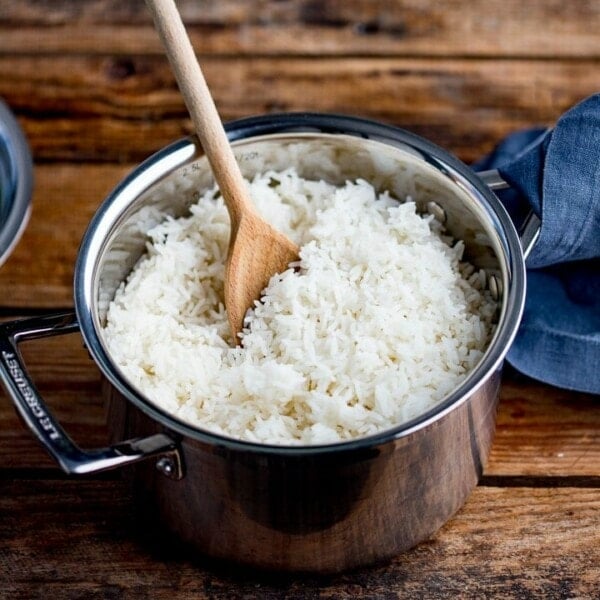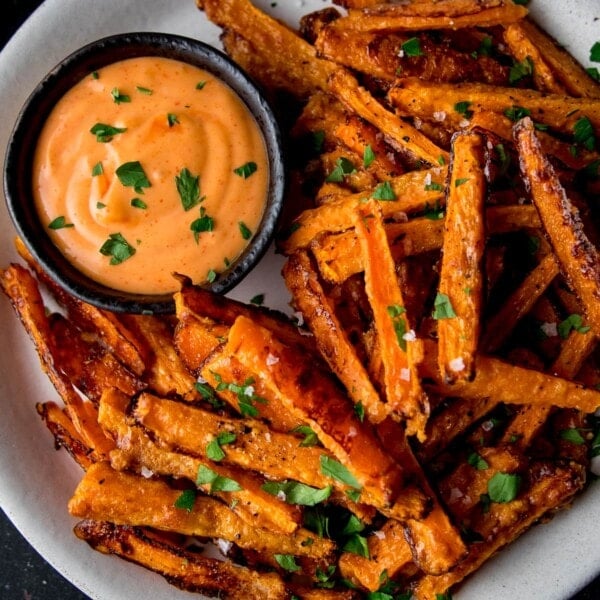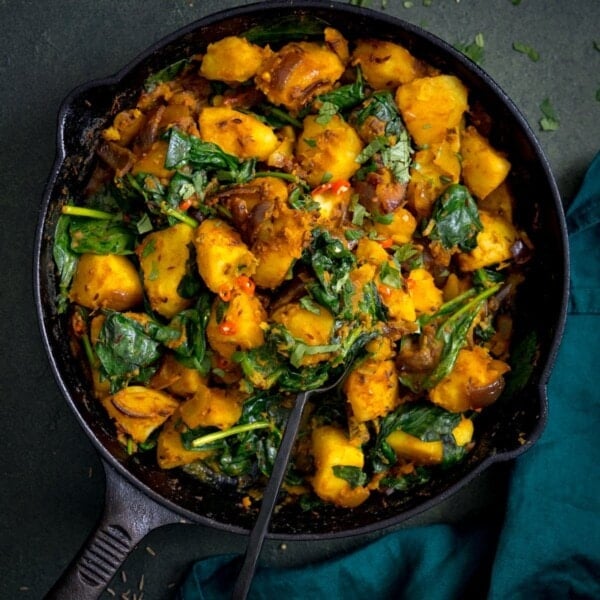We’ve tested 12 different methods to figure out how to make the BEST baked potato– with a crunchy, flavourful skin, and a tender, fluffy interior.
There were a couple of terrible methods, some pretty good methods, and a few contenders that also came close to the top spot.
Let’s take a look.
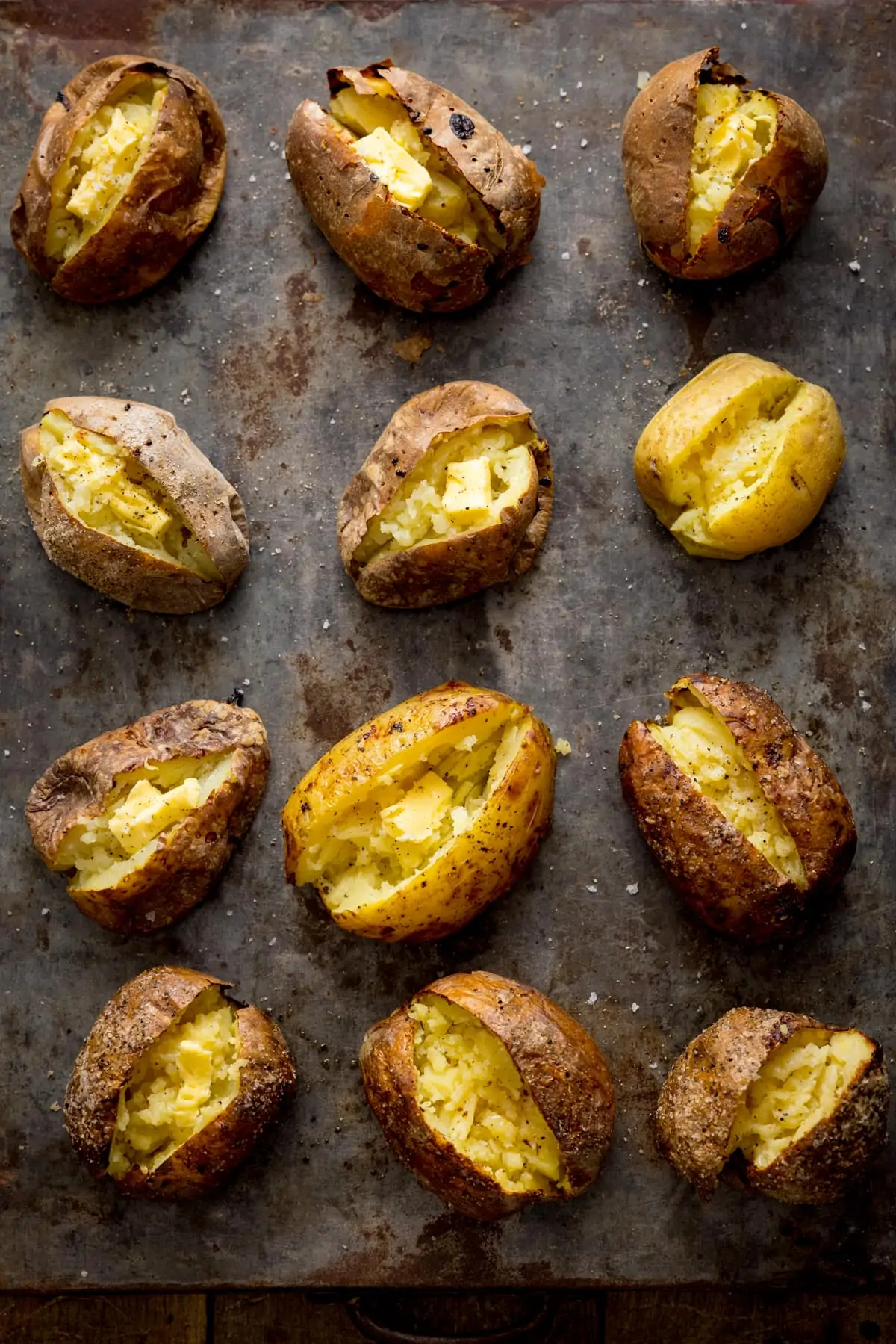
Usually when I bake a potato, I just prick the potato and stick it in the oven for an hour or so. I never really thought about it, until I had a really disappointing jacket spud at a cafe. I’m pretty sure it was microwaved, and it was wrinkly, soft and flavourless.
That got me thinking, that yes, the jacket potatoes I bake at home are better, but are they they best? What could I do better to make a baked spud that would be truly outstanding.
So I decided to do a little test.
Then I started thinking about all the possible different options:
- Should the potato be seasoned?
- Coated in oil?
- Wrapped in foil?
- Microwaved for all or part?
- Baked directly on the wire rack rather than a tray?
- Baked long, slow and low?
- Baked quicker at a higher temperature?
So it very quickly turned into a longer, more comprehensive test, looking at 12 different methods.
I’m still not covering every method in the whole wide world here (sorry, no airfryers, crockpots, BBQs or Instant pots), but I can honestly say, 2 of the potato methods I tested resulted in the best baked potatoes I’ve ever tasted.

🔪 The 12 methods
For every method, I pricked the potato several times, using a fork, as the first step. We don’t want any exploding potatoes after all.
- Baked at 200C/400F for 70 minutes, directly on the rack.
- Baked at 180C/350F for 2 hours, directly on the rack.
- Baked at 200C/400F for 25 minutes, then 180C/350F for 1 hour, directly on the rack.
- Place the potato under the tap to wet, then roll in salt and pepper and bake at 200C/400F for 70 minutes, directly on the rack. This is based on a method by Nigel Slater.
- Baked at 200C/400F for 70 minutes, on a baking tray, rather than directly on the rack.
- Microwaved on high for 10 minutes.

- Microwaved on high for 5 minutes, then baked at 200C/400F for 30 minutes, directly on the rack.
- Potato rubbed in olive oil, salt and pepper, then wrapped in foil and baked at 200C/400F for 70 minutes, directly on the rack.
- Potato rubbed in olive oil, salt and pepper, then baked at 200C/400F for 70 minutes, directly on the rack.
- Potato rubbed in beef dripping, salt and pepper, then baked at 200C/400F for 70 minutes, directly on the rack.
- Microwaved on high for 5 minutes, then brushed with melted beef dripping and sprinkled with salt and pepper, then baked at 220C/425 F for 55 minutes, directly on the rack.
- Potato rubbed in beef dripping, salt and pepper, then baked at 180C/350F for 2 hours, directly on the rack.
The Results:
Potato 1 (Baked at 200C/400F for 70 minutes, directly on the rack)
The skin was crisp, but thin, so it went soft very quickly. Nice fluffy interior.
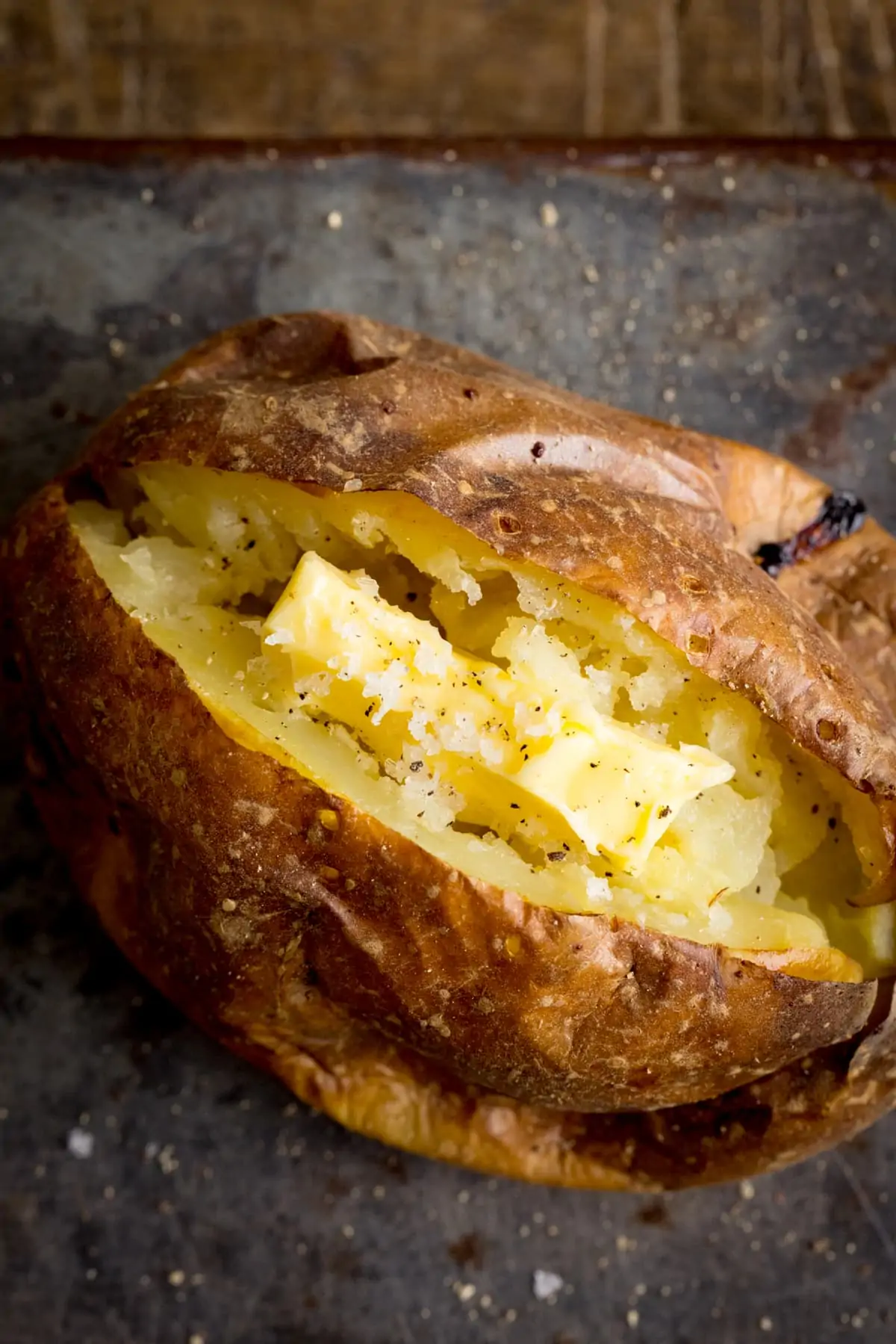
Potato 2 (Baked at 180C/350F for 2 hours, directly on the rack
🥉3rd place🥉
The skin was thicker than potato 1, and crispy, but a little papery. The skin stayed crisp for a good 10-15 minutes, then went a little chewier, but with a lovely smoky potato skin flavour. If I didn’t want to go to the effort of oiling and seasoning my baked potato, this would be my favourite.

Potato 3 (Baked at 200C/400F for 25 minutes, then 180C/350F for 1 hour, directly on the rack)
Similar to potato 1, the skin was crisp (but not quite as crispy as potato 1), but a thin skin, so it went soft very quickly. Nice fluffy interior.

Potato 4 (Place the potato under the tap to wet, then roll in salt and pepper and bake at 200C/400F for 70 minutes, directly on the rack. Based on a method by Nigel Slater.)
Sorry Nigel, this was not good. The skin was soft, pale and thin, with no crunch. Interior was soft and fluffy though.

Potato 5 (Baked at 200C/400F for 70 minutes, on a baking tray, rather than directly on the rack)
Same as potato 1. The skin was crisp, but thin, so it went soft very quickly. Nice fluffy interior. I found there is no difference in baking on a tray, compared to baking directly on the wire rack.

Potato 6 (Microwaved on high for 10 minutes)
Just bleurgh. What a depressing potato. Soft skin – like damp tissue. The interior was a little on the waxy side.
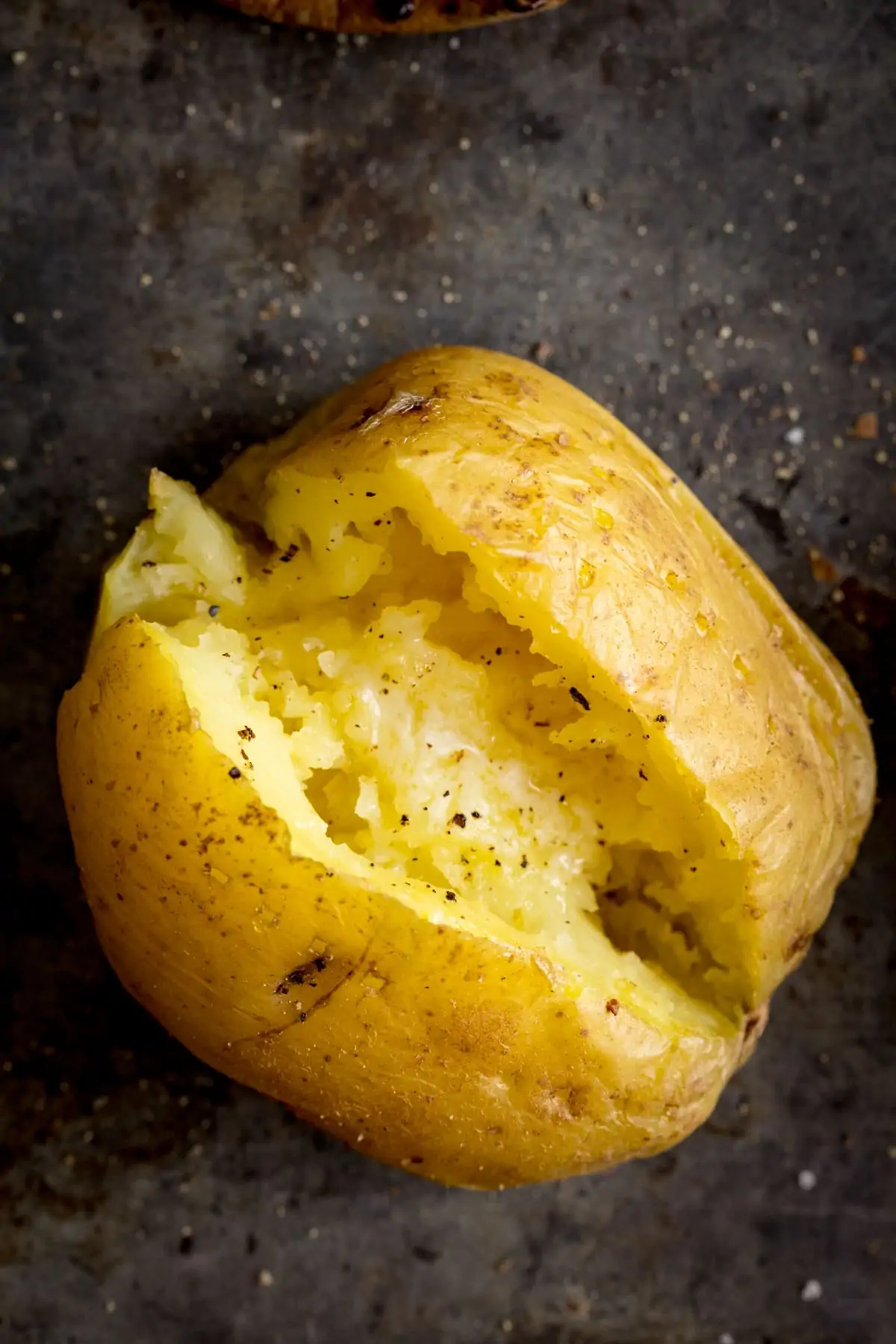
Potato 7 (Microwaved on high for 5 minutes, then baked at 200C/400F for 30 minutes, directly on the rack)
The skin was wrinkly and went soft very quickly (within a couple of minutes), BUT the flavour of the skin was good, and the interior was soft and fluffy.

Potato 8 (Potato rubbed in olive oil, salt and pepper, then wrapped in foil and baked at 200C/400F for 70 minutes, directly on the rack)
Wow! Although this potato was slightly on the larger side to begin with, it didn’t shrink down at all in the oven. Wrapping in foil stopped the moisture escaping, so it didn’t shrink in size slightly like all the other potatoes.
Keeping the moisture in, and protecting the skin from the direct heat of the oven with the foil, also meant the skin didn’t brown very much, and the skin stayed very soft.

Potato 9 (Potato rubbed in olive oil, salt and pepper, then baked at 200C/400F for 70 minutes, directly on the rack)
I really thought coating the potato in oil, salt and pepper would make the skin go crispier, but surprisingly, it didn’t go very crisp and was more on the chewy side. I think, regardless of whether you’re coating in oil or not, baked potatoes need longer in the oven (i.e 2 hours) or a bit of pre-cooking, then a higher cooking temperature (i.e. 220C – see potato 11), to obtain really crispy skin.
However the skin tasted nice, and the inside was fluffy.

Potato 10 (Potato rubbed in beef dripping, salt and pepper, then baked at 200C/400F for 70 minutes, directly on the rack)
This is the point I had a brainwave, and decided to use beef dripping on the skin, instead of oil. It was cooked in the same way as potato 9, so it had the same results, but with slightly better tasting skin (yay beef dripping! Let’s experiment more with that).

Potato 11 (Microwaved on high for 5 minutes, then brushed with melted beef dripping and sprinkled with salt and pepper, then baked at 220C/425 F for 55 minutes, directly on the rack)
🏆Winner!!🏆
A BEAUTIFUL crunchy, crispy skin, that was full of flavour (beef dripping plus seasoning ROCKS) and stayed lovely and crunchy, even after 15 minutes. The inside was lovely and fluffy too. My favourite in terms of crunch, flavour and speed or cooking.

Potato 12 (Potato rubbed in beef dripping, salt and pepper, then baked at 180C/350F for 2 hours, directly on the rack)
🥈2nd place🥈
Sticking with the beef dripping addition, but using the same cooking method as potato 2, this potato would be my top choice if I had plenty of time, and I didn’t have a microwave. This potato only just lost out to potato 11 because it took longer to cook, but the skin crunch and flavour, plus the fluffy interior were the same as potato 11.

So there we go. I’ve never eaten so many potatoes in such a short period of time, but it was a happy happy day.
I totally recommend that you try beef dripping on your baked potatoes. I will be using it forever more!
Check out the recipe post for the best baked potato method – that goes through the winning baked potato recipe, along with a few more tips and a printable recipe card.
Will this change the way you bake potatoes? I’d love to know in the comments.
🍲 More potato sides
I LOVE a potato side dish and I often serve more than one especially when I’m doing a roast dinner.
Stay updated with new recipes!
Subscribe to the newsletter to hear when I post a new recipe. I’m also on YouTube (new videos every week) and Instagram (behind-the-scenes stories & beautiful food photos).
Some of the links in this post may be affiliate links – which means if you buy the product I get a small commission (at no extra cost to you). If you do buy, then thank you! That’s what helps us to keep Kitchen Sanctuary running. The nutritional information provided is approximate and can vary depending on several factors. For more information please see our Terms & Conditions.












